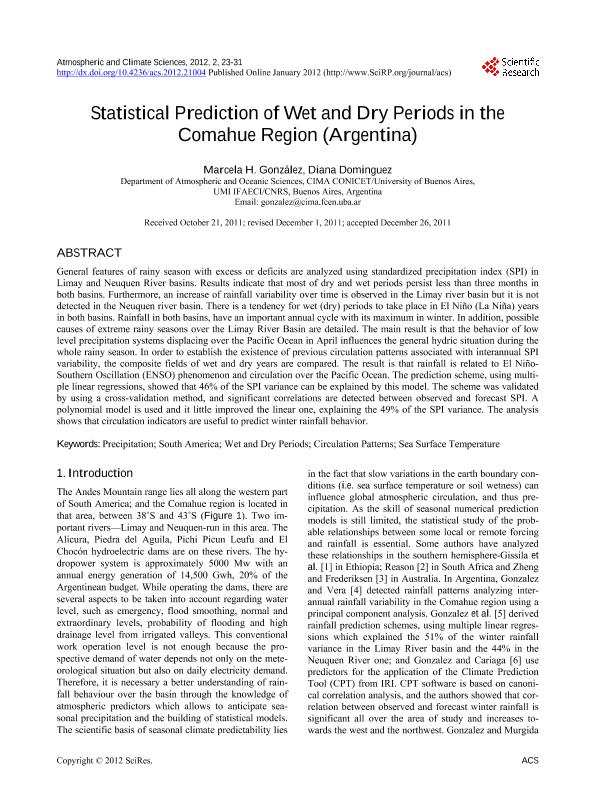Mostrar el registro sencillo del ítem
dc.contributor.author
González, Marcela Hebe

dc.contributor.author
Domínguez, Diana

dc.date.available
2017-06-01T20:47:46Z
dc.date.issued
2012-01
dc.identifier.citation
González, Marcela Hebe; Domínguez, Diana; Statistical Prediction of wet and dry periods in the Comahue Region (Argentina); Scientific Research; Atmospheric and Climate Sciences; 2; 1; 1-2012; 23-31
dc.identifier.issn
2160-0414
dc.identifier.uri
http://hdl.handle.net/11336/17324
dc.description.abstract
General features of rainy season with excess or deficits are analyzed using standardized precipitation index (SPI) in Limay and Neuquen River basins. Results indicate that most of dry and wet periods persist less than three months in both basins. Furthermore, an increase of rainfall variability over time is observed in the Limay river basin but it is not detected in the Neuquen river basin. There is a tendency for wet (dry) periods to take place in El Niño (La Niña) years in both basins. Rainfall in both basins, have an important annual cycle with its maximum in winter. In addition, possible causes of extreme rainy seasons over the Limay River Basin are detailed. The main result is that the behavior of low level precipitation systems displacing over the Pacific Ocean in April influences the general hydric situation during the whole rainy season. In order to establish the existence of previous circulation patterns associated with interannual SPI variability, the composite fields of wet and dry years are compared. The result is that rainfall is related to El Niño- Southern Oscillation (ENSO) phenomenon and circulation over the Pacific Ocean. The prediction scheme, using multiple linear regressions, showed that 46% of the SPI variance can be explained by this model. The scheme was validated by using a cross-validation method, and significant correlations are detected between observed and forecast SPI. A polynomial model is used and it little improved the linear one, explaining the 49% of the SPI variance. The analysis shows that circulation indicators are useful to predict winter rainfall behavior.
dc.format
application/pdf
dc.language.iso
eng
dc.publisher
Scientific Research
dc.rights
info:eu-repo/semantics/openAccess
dc.rights.uri
https://creativecommons.org/licenses/by-nc-sa/2.5/ar/
dc.subject
Precipitation
dc.subject
South America
dc.subject
Wet And Dry Periods
dc.subject
Circulation Patterns
dc.subject
Sea Surface Temperature
dc.subject.classification
Otras Ciencias Naturales y Exactas

dc.subject.classification
Otras Ciencias Naturales y Exactas

dc.subject.classification
CIENCIAS NATURALES Y EXACTAS

dc.title
Statistical Prediction of wet and dry periods in the Comahue Region (Argentina)
dc.type
info:eu-repo/semantics/article
dc.type
info:ar-repo/semantics/artículo
dc.type
info:eu-repo/semantics/publishedVersion
dc.date.updated
2017-05-31T19:43:57Z
dc.journal.volume
2
dc.journal.number
1
dc.journal.pagination
23-31
dc.journal.pais
Estados Unidos

dc.description.fil
Fil: González, Marcela Hebe. Consejo Nacional de Investigaciones Científicas y Técnicas. Oficina de Coordinación Administrativa Ciudad Universitaria. Centro de Investigaciones del Mar y la Atmosfera. Universidad de Buenos Aires. Facultad de Ciencias Exactas y Naturales. Centro de Investigaciones del Mar y la Atmosfera; Argentina
dc.description.fil
Fil: Domínguez, Diana. Universidad de Buenos Aires. Facultad de Ciencias Exactas y Naturales. Departamento de Ciencias de la Atmósfera y los Océanos; Argentina
dc.journal.title
Atmospheric and Climate Sciences
dc.relation.alternativeid
info:eu-repo/semantics/altIdentifier/doi/http://dx.doi.org/10.4236/acs.2012.21004
dc.relation.alternativeid
info:eu-repo/semantics/altIdentifier/url/http://www.scirp.org/journal/PaperInformation.aspx?PaperID=17124
Archivos asociados
